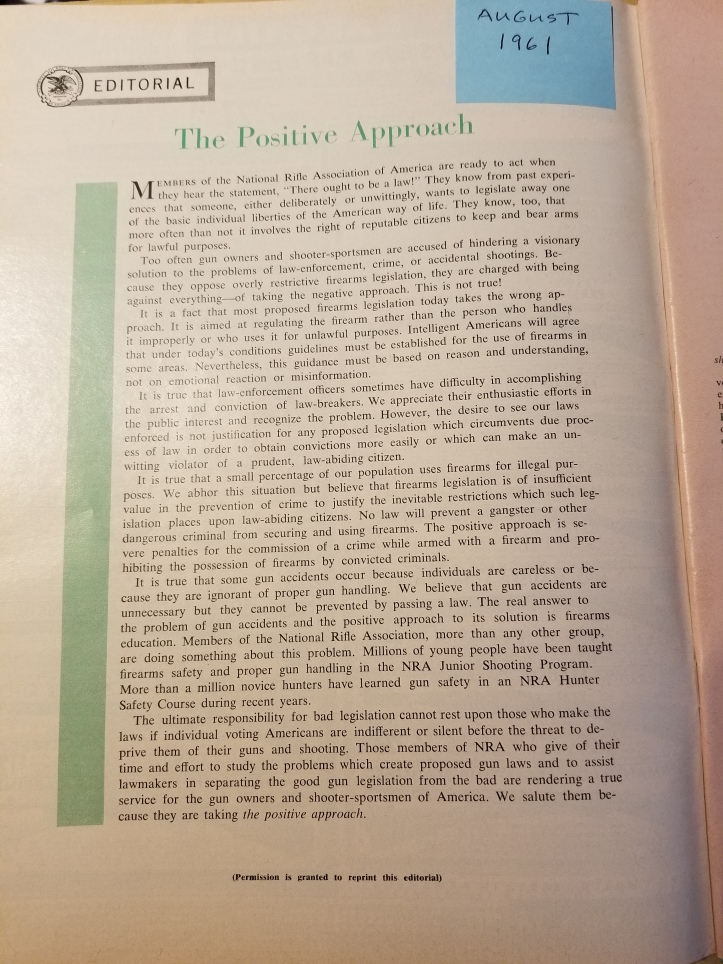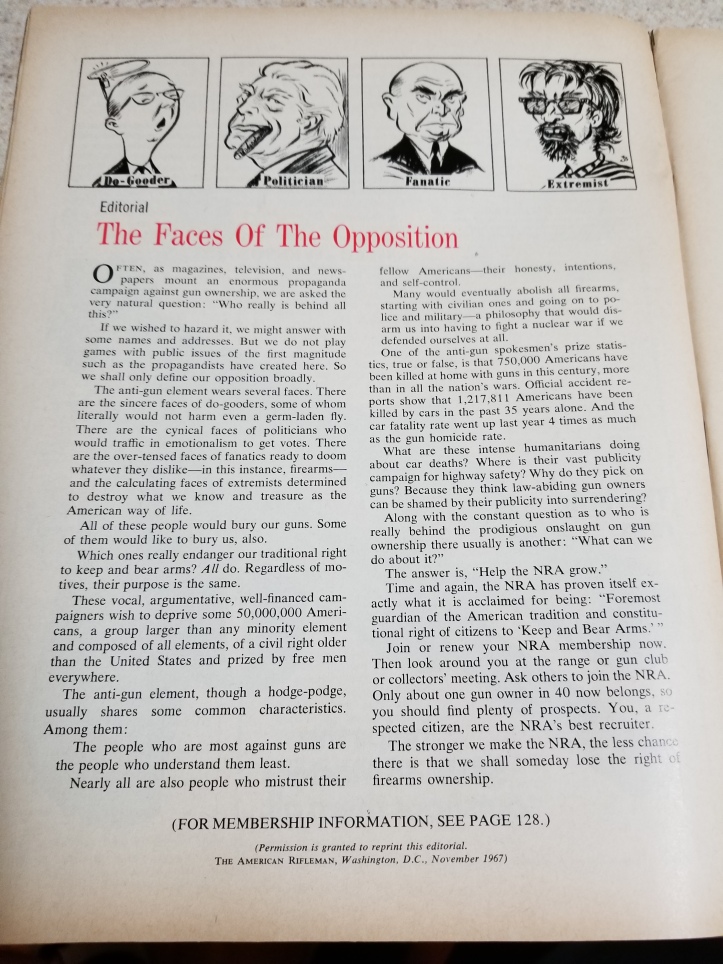That which has been is what will be, That which is done is what will be done, And there is nothing new under the sun (Ecclesiastes 1:9).
Reading year after year of The American Rifleman, this well-known passage from the Tanakh ring ever so true.
Two examples below are similar to others I have found, from 1929 and from the 1940s and 1950s.
50+ years ago, an August 1961 editorial reacts to legislative threats to “one of the basic individual liberties of the American way of life” – “the right of reputable citizens to keep and bear arms for lawful purposes.” It encourages laws that regulate persons not firearms. It maintains that laws will not prevent criminal from getting guns.
It argues that gun accidents will not be prevented by laws; to the contrary, gun safety education is essential to reducing such accidents and the National Rifle Association is the leading organization providing such education (then, as now).
Almost 50 years ago, in November 1967, another editorial reacts to propaganda campaigns waged by the media against gun ownership, and argues that various anti-gun extremists are behind the effort “to destroy what we know and treasure as the American way of life.”
Common elements with today’s situation:
-Well-financed anti-gun campaign (pre-Bloomberg): “These vocal, argumentative, well-financed campaigners wish to deprive some 50,000,000 Americans, a group larger than any minority element and composed of all elements, of a civil right older than the United States and prized by free men everywhere.”
-Ignorance of guns: “The people who are most against guns are the people who understand them least.”
-Comparing civilian firearms deaths to war deaths (though without contemporary infographics): “One of the anti-gun spokesmen’s prize statistics, true or false, is that 750,000 Americans have been killed at home with guns in this century, more than in all the nation’s wars.”
-Comparing firearms deaths to car deaths: “the car fatality rate went up last year 4 times as much as the gun homicide rate. What are these intense humanitarians doing about car deaths?”
These small finds as I work my way through the past 100 years of The American Rifleman continue to reinforce to me that the increasingly hard line political stance of the National Rifle Association in defense of gun rights has developed symbiotically with the increasingly hard line political stance against guns by its opponents.



[…] Source: Gun Rights and Gun Control: Nihil sub sole novum […]
LikeLike
“… the increasingly hard line political stance of the National Rifle Association in defense of gun rights has developed symbiotically with the increasingly hard line political stance against guns by its opponents…”
More or less agree. But as more and more Americans live in cities and as hunting becomes less relevant, the switch to Gun Culture 2.0 changes the shape of the field as well, i.e., people see guns as threats to urban life rather than as someone with a gun innocuously chasing Bambi around in the woods.
As we are seeing with climate science, in a battle between ideology and data, the data come in a distant second.
LikeLiked by 1 person
Part of the symbiosis I think. 20th century gun control driven by concerns about crime which has almost always been an urban issue.
LikeLiked by 2 people
Yep. An urban issue as it always has been. Plus, the major anti-gun organizations focus on mass killings, which affect empowered (white, middle and upper class, etc) people and magnify the scope of mass killing problem. When was the last time Everytown focussed on the south side of Chicago rather than on Newtown? Of course the gun rights folks are equally myopic, pointing to the S. side of Chicago even though few of the gun owning constituents live in urban war zones. Both sides use nice looking but largely meaningless correlations. Sigh.
The other change is perhaps to social media. It is rare to see a real discussion these days but rather the arguments boiled down to insipid Facebook or Twitter statements of 140 characters or less, such as the “stop the NRA’s murder insurance” post I saw the other day and sent you (or did you send it to me?). When discussions are reduced to flame wars, civil discourse as well as nuance goes down the drain pretty fast. We are all reduced to monsters in the eyes of the other. Kind of a national version of Evergreen State College.
well, I better walk the dog and get to work.
LikeLiked by 1 person
Since Bambi never existed, your assumption is questionable.
LikeLike
Reblogged this on .
LikeLike
David, you said that the authors of Armed with Reason use only data that support their presuppositions. With that in mind, my question for you is what is the good data in favor of the Second Amendment? AWR is highly dismissive of a lot of the data commonly cited by pro-gun people(especially John Lott and Kleck/Gertz), and to me, seem to have taken it down piece by piece, and that has really destroyed my confidence in my ability to defend the Second. However I have found some issues in a couple of their articles(namely the article “debunking” the notion that armed populations can protect themselves from oppressive governments, and the article telling us why we don’t need those scary ole assault rifles).
LikeLike
Edit: Anyone is welcome to reply to this comment.
LikeLike
This is a really good question. In my opinion, the strongest arguments in favor of the Second Amendment aren’t empirical (grounded in data) but legal/political. The right to keep and bear arms is a Constitutionally protected right and “the data” don’t matter in that sense.
Of course, my whole blog is premised on trying to empirically understand the role of guns in American society. So I do care what the data say. And I was surprised/disappointed to see how politically motivated some gun research is. To be sure, the consequences that Kellerman and others have drawn in terms of gun control go well beyond what their data say. (I’ve posted about this before.)
At the same, there is no question that John Lott has done some unacceptable things in the past, and Kleck’s unyielding defense of his DGU numbers seem too stubborn.
Consequently, I find myself having to evaluate research on a case-by-case basis, reading the articles and trying to determine for myself what they say. This is a big part of what I do in my Sociology of Guns Seminar. It’s not easy and I wish I could just point to someone and say: “You can trust what this person says 100% of the time.”
The best I can advise short of reading all the research (impossible) is to assume that the truth lies somewhere in the middle of the extremes. E.g., there are probably fewer DGUs annually than Kleck says and more than the gun control researchers say.
Hope these thoughts help.
LikeLike
This was an excellent comment. Do you think if the authors of Armed with Reason were reading the end your comment, might they accuse you of the middle ground fallacy?(I’m not sure I understand fallacies as well as I once believed I did.) Even if they did, I’m not sure if it would matter since several other researchers(maybe even the National Research Council?)say that while Kleck’s numbers are probably too high, others such as that of David Hemenway(I believe his are 1,600), are considered far too low.
LikeLike
Not really sure what they would think. As I recall, their efforts are mostly directly at de-bunking Kleck’s high estimate as opposed to supporting some of the very low estimates (though they may do that). If you have a chance to read their stuff on this point again or more closely than I did, let me know what they say.
LikeLike
I can’t recall for sure whether or not they were supporting the low estimates, but now that I think about it, I think they did. I can’t remember them arguing for anything other than we know that there are about 1,600 DGUs in America a year based on police and hospital records. This of course doesn’t account for would-be perps taking off after a victim brandishes a gun, and I don’t recall them even mentioning that. They might have a study that could give them confidence that that isn’t a common occurrence(seems they have a study for everything), but I doubt I would need to be very afraid of that. The thing that I’ve come to figure out about the gun debate is that there is little corroboration for either side(though I’m sure Evan DeFillipis and Devin Hughes would disagree, and I know for a fact that David Hemenway thinks the evidence is absolutely on his side.)
LikeLike
I need to use paragraphs more. Probably.
LikeLike
As long as bearing arms is a right there isnt much to discuss other then the date for it to be brought to the Supreme Court for clarification. On that day, a lot of laws will be declared unconstitutional.
LikeLike
A bit of a simplistic view insofar as the Supreme Court does not exist outside of our culture and poltics.
LikeLike
[…] have previously used the phrase, Nihil sub sole novum, a snippet from the wisdom of Ecclesiastes in the Hebrew Bible: “That which has been is what […]
LikeLike
[…] wedge issue beginning in the late 1960s and early 1970s, was certainly not a one-sided affair. As I have noted previously, the increasingly hard-line political stance of the National Rifle Association in defense of gun […]
LikeLike